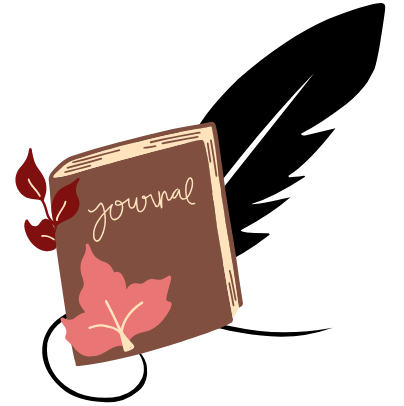As someone who’s been journaling for years, I know firsthand how transformative this practice can be. But I also know the frustration of staring at a blank page, unsure where to begin.
That’s why I’m excited to share these fun journaling prompts for adults. They’re designed to spark your imagination, challenge your perspective, and lead you down unexpected paths of self-discovery.
Why Playful Prompts Matter
Playfulness isn’t just for kids. As adults, we often forget how crucial play is for our creativity, problem-solving skills, and emotional well-being.
Fun journaling prompts tap into that playful spirit, allowing us to approach our thoughts and feelings from fresh angles.
They help us:
- Break out of mental ruts
- Explore new aspects of our personality
- Process emotions in a lighthearted way
- Boost creativity and imagination
- Reduce stress and anxiety
Here’s some prompts that will add a spark of joy to your journaling practice.
Imaginative Scenarios
These prompts encourage you to think outside the box and tap into your inner child:
1. Superhero for a Day
If you woke up with a superpower tomorrow, what would it be and how would you use it? Dive deep into the details.
Would you use your power for good or mischief?
How would it change your daily routine?
I might choose the ability to teleport. I’d use it to visit far-off places on my lunch break, surprise friends with impromptu visits, and maybe sneak into a few exclusive events.
But I’d also use it for good – rescuing people from dangerous situations or delivering urgent medical supplies to remote areas.
2. Alien Ambassador
You’ve been chosen as the ambassador to an alien species. Describe your first meeting.
Consider the aliens’ appearance, communication methods, and cultural norms.
How would you represent humanity?
In my scenario, the aliens talk through color changes in their skin, like advanced chameleons. I’d bring a team of artists to help “translate” our messages visually.
I’d focus on showcasing human creativity, compassion, and our ability to overcome differences – while also being honest about our flaws and areas for growth.
3. A Day in the Life of Your Pet
Write a day in the life of your pet, from their perspective. What does your furry (or scaly) friend really think about their daily routine?
What adventures do they have when you’re not looking?
My cat, Whiskers, probably spends her day plotting world domination between naps. She sees the vacuum cleaner as her mortal enemy and believes she’s protecting me from it.
When I’m gone, she hosts elaborate tea parties with her toy mice, discussing the latest neighborhood gossip.
Time Travel Prompts
Time travel prompts allow us to explore our past, present, and future selves in creative ways:
1. Letter to Your 10-Year-Old Self
Write a letter to your 10-year-old self. What advice would you give?
Be specific and compassionate.
What do you wish you had known at that age?
Dear 10-year-old me,
You’re about to enter some challenging years, but I promise it gets better. That weird, awkward phase?
Everyone goes through it.
Be kind to yourself. Those hobbies you think are “uncool”?
Keep pursuing them – they’ll bring you joy and even lead to career opportunities later.
Most importantly, trust your instincts. You’re smarter and stronger than you realize.
Don’t let anyone make you feel small.
And please, for the love of all that is holy, don’t get that perm in 8th grade. Trust me on this one.
Love,
Your future self
2. 20 Years in the Future
Think of your life 20 years from now. Describe a typical day.
Don’t hold back – dream big!
What have you accomplished? How has the world changed?
I wake up in my eco-friendly smart home, powered entirely by renewable energy. My AI assistant briefs me on the day’s schedule as I enjoy my lab-grown, ethically produced breakfast.
I head to my virtual reality office, where I collaborate with colleagues from around the world on solving global challenges.
In the afternoon, I mentor young entrepreneurs through a holographic mentorship program. The evening is spent with family, sharing stories of our recent trip to the first sustainable colony on Mars.
Before bed, I review the progress of my foundation, which focuses on providing universal access to education and healthcare.
3. Reliving One Perfect Day
If you could relive one day of your life, which would it be and why? Explore the emotions and sensory details of that day.
What made it so special?
I’d choose the day I hiked to a hidden waterfall with my best friends. The air was crisp with the scent of pine, and the forest floor was soft beneath our feet.
We laughed, shared deep conversations, and marveled at the beauty around us.
When we reached the waterfall, the mist cooled our skin as we swam in the crystal-clear pool below.
What made it special wasn’t just the scenery, but the feeling of finish presence and connection – with nature, with my friends, and with myself. It was a day where time seemed to stand still, and all the worries of the world faded away.
Quirky Self-Reflection
These prompts encourage self-reflection with a twist, helping you gain insights into your personality and values:
1. Your Life as a Recipe
If your life were a recipe, what would be the ingredients? Think beyond the obvious.
What “spices” add flavor to your life?
What “secret ingredients” make you unique?
Ingredients for My Life:
- 2 cups of curiosity
- 1 tablespoon of wanderlust
- A pinch of stubbornness
- 3 heaping spoonfuls of creativity
- 1/2 cup of introversion, balanced with a dash of social butterfly
- A sprinkle of dad jokes (for flavor)
- 1 cup of coffee (for sanity)
- Generous amounts of love and friendship
Secret ingredient: A dollop of childlike wonder, to keep things fresh and exciting.
Mix well, let simmer over time, and serve with a side of adventure.
2. Your Superhero Alter Ego
Create a superhero alter ego for yourself. What’s your origin story?
Consider your strengths, weaknesses, and life experiences.
How do they shape your superhero identity?
Meet “The Empath” – a superhero born from a lifetime of keen observation and emotional intelligence. My origin story involves a freak accident with a malfunctioning mood ring that fused with my nervous system, giving me the ability to sense others’ emotions but to manipulate and transfer them.
My strengths include defusing tense situations, bringing people together, and helping others process difficult feelings. My weakness?
I’m easily overwhelmed in crowded places and have to be careful not to absorb too much negative energy.
My costume features color-changing fabric that reflects the emotions around me, and I carry a “mood-balancing” staff that helps channel and direct emotional energy. My mission is to foster understanding and compassion in a world that often feels divided.
3. If You Were a Color
If you were a color, what would you be and why? Explore the emotions, associations, and memories you connect with different colors.
I’d be a deep, rich teal. It’s a color that embodies both the calming blues of the ocean and the grounding greens of nature.
Teal represents balance, creativity, and emotional healing – all qualities I strive for in my life.
This color reminds me of tropical waters I’ve swum in, of the gemstone jewelry my grandmother wore, and of the first apartment I painted when I moved out on my own. It’s a color that feels both familiar and full of possibility.
Teal is often associated with clarity of thought and communication, which resonates with my love of writing and sharing ideas. It’s also a color that stands out without being overpowering – much like how I aim to make my mark on the world in a meaningful yet humble way.
Creative Problem-Solving
Sometimes, approaching problems from a playful angle can lead to unexpected solutions:
1. Invent a Problem-Solving Machine
Invent a machine that solves your biggest pet peeve. How does it work?
Get detailed with your description.
What materials does it use? How big is it?
Introducing the “Procrastination Pulverizer 3000” – a sleek, desk-sized device designed to combat even the most stubborn cases of task avoidance.
The machine is crafted from a unique alloy of titanium and unobtanium, making it both lightweight and indestructible (because let’s face it, we procrastinators can be pretty destructive when avoiding work).
Here’s how it works:
- You input your to-do list into the touchscreen interface.
- The machine analyzes your tasks, your energy levels, and your schedule using advanced AI and your personal biorhythm data.
- It then creates a customized work plan, breaking tasks into manageable chunks.
- The “Focus Field Generator” creates a bubble around your workspace, blocking out distractions and boosting concentration.
- The “Motivation Mister” periodically sprays a custom blend of aromatherapy scents designed to keep you energized and on-task.
- If you try to access social media or other time-wasting sites, the “Gentle Reminder Gloves” give your hands a tiny, harmless shock.
- As you finish tasks, the “Achievement Amplifier” releases small doses of dopamine, reinforcing your productivity.
- For particularly challenging tasks, the “Virtual Reality Visualizer” shows you a simulation of how great you’ll feel once the task is done.
The Procrastination Pulverizer 3000 comes in a range of colors to match any décor and can be easily folded and stored when not in use (but let’s be honest, for most of us, it would be in constant use).
2. Dialogue Between Inner Voices
Write a dialogue between your inner critic and your biggest cheerleader. Give each voice a distinct personality.
How do they interact?
Can they find common ground?
Inner Critic (IC): sighs dramatically Well, well, well. Look who’s trying to write again. Don’t you remember how badly your last try went?
Inner Cheerleader (ICH): bounces in excitedly Hey now! That’s not fair.
Every try is progress!
We learned so much from that last try.
IC: rolls eyes Oh please. Learning is just a consolation prize for failure.
ICH: Failure? No way!
It was a stepping stone to success.
Remember how much better the structure was compared to the first draft?
IC: grudgingly I suppose there were… minor improvements.
ICH: See? And this time will be even better!
We’ve got new ideas, more practice, and—
IC: interrupts And the same mediocre talent. Let’s be realistic here.
ICH: gently Being realistic doesn’t mean being negative. Our talent grows with every word we write.
IC: softens slightly I just don’t want us to get hurt by aiming too high.
ICH: I understand. But what if aiming high is exactly what we need to grow?
IC: considers Maybe… but how do we know we’re ready?
ICH: We don’t! That’s the exciting part.
We learn by doing.
IC: sighs Fine. But I reserve the right to say “I told you so” if it goes badly.
ICH: Deal! And I reserve the right to say “I told you so” when it goes amazingly well!
They shake hands, a truce formed when you’re trying to achieve growth
3. Life as a Video Game
If your life were a video game, what would be the current mission or quest? Think about your goals and challenges in terms of levels, power-ups, and boss battles.
Current Mission: “The Career Crossroads Conundrum”
Objective: Navigate a major career transition while maintaining work-life balance and personal growth.
Levels:
- Skill Assessment Dungeon: Identify transferable skills and areas for improvement.
- Networking Maze: Connect with professionals in the desired field.
- Resume Renovation: Craft a compelling narrative of your experience.
- Interview Island: Master the art of showcasing your value to potential employers.
- Negotiation Ninja: Secure a position with optimal compensation and benefits.
Power-Ups:
- Coffee Boost: Temporary energy and focus increase
- Meditation Moment: Stress reduction and clarity enhancement
- Friend Phone-a-Friend: Get advice and moral support from your inner circle
- Professional Development Potion: Gain new skills through courses and workshops
Boss Battles:
- The Imposter Syndrome Ogre: Overcome self-doubt and own your abilities
- The Work-Life Balance Behemoth: Learn to set boundaries and prioritize self-care
- The Financial Uncertainty Fiend: Navigate the challenges of a career change on your budget
Side Quests:
- Hobby Harmony: Maintain personal interests during the transition
- Health Hero: Keep up with exercise and healthy eating habits
- Relationship Reinforcement: Nurture important connections while focusing on career goals
Remember, respawns are unlimited, and every setback is just a chance to level up your resilience stats!
Sensory Exploration
Engaging our senses can lead to rich, vivid writing:
1. Your Perfect Meal
Describe your perfect meal using all five senses. Don’t just focus on taste – consider the ambiance, textures, and even the sound of your utensils.
The gentle clink of fine china and the soft murmur of conversation fill the air as I’m seated at a table overlooking the Mediterranean. The setting sun paints the sky in hues of pink and gold, reflecting off the water and casting a warm glow on the white tablecloth.
The first course arrives: a chilled gazpacho. The bowl is cool to the touch, and as I lift the spoon to my lips, I catch the fresh scent of tomatoes, cucumbers, and a hint of garlic.
The soup is silky smooth, with a pleasant acidity that dances on my tongue.
Next comes a perfectly seared scallop atop a bed of creamy risotto. The scallop has a golden-brown crust that makes a satisfying crunch as I cut into it, revealing the tender, pearly flesh inside.
The risotto is infused with saffron, giving it a vibrant yellow color and a subtle, earthy aroma.
The main course is a succulent lamb tagine, served in a traditional clay pot. As the lid is lifted, a cloud of fragrant steam escapes, carrying notes of cinnamon, cumin, and apricots.
The meat is so tender it falls off the bone, and the sauce is rich and complex, with a perfect balance of sweet and savory.
For dessert, a delicate lavender crème brûlée. The spoon makes a crisp, crackling sound as it breaks through the caramelized sugar top.
The custard beneath is cool and velvety, with a subtle floral note that transports me to the lavender fields of Provence.
As I sip the last of my wine, a crisp local white that tastes of sunshine and sea air, I feel utterly content. This meal hasn’t just satisfied my hunger – it’s been a journey for all my senses, creating memories that will linger long after the plates have been cleared.
2. The Soundtrack of Your Life
Create a playlist for your life right now. Explain why you chose each song.
How do the lyrics or melodies reflect your current experiences and emotions?
- “Here Comes the Sun” by The Beatles
- Represents hope and new beginnings as I begin on a new chapter in life
- “Unwritten” by Natasha Bedingfield
- Captures the excitement and uncertainty of having a blank slate
- “Stressed Out” by Twenty One Pilots
- Reflects the nostalgia and occasional overwhelm of adult responsibilities
- “Fight Song” by Rachel Platten
- My anthem for perseverance when facing challenges
- “Shake It Off” by Taylor Swift
- Reminds me not to take criticism or setbacks too seriously
- “Landslide” by Fleetwood Mac
- Represents the bittersweet nature of growth and change
- “Don’t Stop Me Now” by Queen
- Captures my enthusiasm and energy when I’m in the flow of a project
- “Bridge Over Troubled Water” by Simon & – Garfunkel
- Represents the strong support system I’m grateful for
- “What a Wonderful World” by Louis Armstrong
- Reminds me to appreciate the beauty in everyday moments
- “I Wanna Dance with Somebody” by Whitney Houston
- Pure joy and celebration – because life should have a dance break!
This playlist reflects the mix of emotions and experiences I’m now navigating – hope, uncertainty, determination, joy, and gratitude. It’s a reminder that life is a complex symphony, with each song representing a different facet of my journey.
3. The Scent of Your Week
If your week had a scent, what would it be? Get creative with your descriptions.
Is it a complex perfume or a simple, familiar smell?
My week would smell like a hand-crafted artisanal candle called “Productive Chaos.” The scent opens with a bright, invigorating burst of citrus – like the zest of a lemon being squeezed into your morning tea. This represents the fresh energy and optimism of starting new projects.
As the scent develops, you catch whiffs of freshly brewed coffee and the crisp scent of newly printed paper – the essence of busy workdays and important deadlines. There’s a hint of lavender in the middle notes, a calming presence that helps maintain focus amidst the flurry of activity.
Underneath it all is a grounding base of sandalwood and vanilla, representing the comfort of home and family time in the evenings. On some days, you might catch a surprise note of cinnamon or nutmeg – the spice of unexpected challenges or exciting opportunities.
By the end of the week, the scent mellows into a soft, clean linen smell mixed with a touch of sea salt. It’s the relief and relaxation of completing tasks and looking forward to the weekend, with a hint of adventure on the horizon.
This complex fragrance captures the multifaceted nature of my week – busy and chaotic at times, but ultimately balanced and fulfilling.
Overcoming Common Journaling Challenges
While these prompts are designed to be fun, you might still encounter some obstacles:
Perfectionism
Many of us struggle with the want to make every journal entry profound or beautifully written. This perfectionism can paralyze us, making it hard to write anything at all.
The key is to give yourself permission to be messy, silly, or imperfect. Your journal is a safe space for exploration, not a polished publication.
Some of the most insightful entries can come from stream-of-consciousness writing or “ugly” first drafts.
Try setting a timer for 5 minutes and writing without stopping, no matter what comes out. You might be surprised by what emerges when you silence your inner critic.
Time Constraints
In our busy lives, it’s easy to feel like we don’t have time for journaling. The solution?
Start small.
Even 5-10 minutes of focused writing can be incredibly useful.
Set a timer and challenge yourself to write without stopping until it goes off. You’ll be stunned by what you can produce in a short time.
This practice can also help you become more effective in your writing over time.
Consider keeping your journal with you throughout the day. You can jot down quick thoughts or observations during breaks or commutes, building up entries bit by bit.
Feeling Stuck
Sometimes, no matter how fun a prompt sounds, we just feel stuck. The words won’t come, or we don’t know where to start.
This is normal and happens to everyone.
If a prompt doesn’t resonate, skip it and try another. Or use it as a jumping-off point to write about something else entirely.
The prompt that sparks your creativity might not be directly related to what you end up writing about – and that’s okay!
Another trick is to start with a simple list. If you’re stuck on describing your perfect day, for example, start by listing 5-10 elements that would be part of that day.
You can expand on these points later.
Privacy Concerns
For many, the fear of others reading their private thoughts can inhibit honest journaling. If this is a concern for you, there are several strategies you can employ:
- Use a password-protected digital journal app.
- Write in code or use symbols for sensitive topics.
- Keep your journal in a locked drawer or safe.
- Practice self-censorship for extremely sensitive information.
Remember, the most important thing is that you feel safe and comfortable in your journaling practice. It’s okay to have boundaries, even with yourself.
Making the Most of Your Prompts
To get the most out of these fun journaling prompts:
Set the Mood
Create a comfortable, inviting space for your journaling practice. This could mean:
- Lighting a scented candle
- Playing soft background music
- Brewing your favorite tea or coffee
- Finding a cozy spot with good lighting
- Using a special pen that feels good to write with
By creating a pleasant environment, you’re signaling to your brain that it’s time to relax and be creative.
Mix It Up
Alternate between serious and playful prompts to keep your practice balanced. While fun prompts can reignite your passion for journaling, reflecting on deeper topics is also valuable.
You might dedicate certain days of the week to different types of prompts, or simply choose based on your mood and needs each day.
Follow Your Curiosity
If a prompt leads you in an unexpected direction, go with it! Some of the best insights come from these detours.
Your subconscious mind might be making connections that your conscious mind hasn’t realized yet.
Don’t feel constrained by the original prompt. If you start writing about your superhero alter ego and end up exploring your real-life strengths and weaknesses, that’s great! The prompts are meant to be springboards, not rigid guidelines.
Reflect on Your Responses
After writing, take a moment to consider what your answers reveal about your thoughts, feelings, or values. You might be surprised by what you explore.
Ask yourself:
- What themes do I notice in my writing?
- Did any of my responses surprise me? Why?
- How do these reflections relate to my current life situation?
- Are there any actions or changes I want to make based on these insights?
This reflection can help deepen your self-awareness and make your journaling practice more impactful.
Share with Others
If you’re comfortable, share your responses with a friend or in a journaling group. This can lead to interesting discussions and new perspectives.
Hearing how others interpret the same prompt can be enlightening and fun.
You might start a journaling circle where you meet regularly to share prompts and discuss your writing. Or, if you prefer more privacy, consider sharing just one insight or favorite line from your journaling with a trusted friend.
Remember, sharing is optional. The most important audience for your journal is you.
Frequently Asked Questions
What are the benefits of journaling for adults?
Journaling offers numerous benefits for adults, including stress reduction, improved mental clarity, enhanced self-awareness, and better emotional regulation. It can also boost creativity, help with problem-solving, and provide a record of personal growth over time.
How often should I journal?
The frequency of journaling is a personal choice. Some people benefit from daily journaling, while others prefer weekly reflections.
The key is consistency.
Start with what feels manageable, even if it’s just 5 minutes a few times a week, and adjust as needed.
What’s the difference between a diary and a journal?
While the terms are often used interchangeably, a diary typically focuses on recording daily events, while a journal often involves more reflection, analysis, and creative expression.
Journals can include prompts, goal-setting, artistic elements, and deeper explorations of thoughts and feelings.
Can journaling help with mental health issues?
Many mental health professionals recommend journaling as a complementary practice for managing conditions like anxiety and depression. It can help identify thought patterns, process emotions, and track progress.
However, it’s not a substitute for professional treatment when needed.
What if I’m not a good writer?
Journaling is for your eyes only, so there’s no need to worry about perfect grammar or eloquent prose. The act of writing itself is what’s useful, not the quality of the writing.
Focus on expressing yourself honestly rather than crafting perfect sentences.
How can I make journaling a habit?
To make journaling a habit, try linking it to an existing routine (like having your morning coffee), setting reminders, or keeping your journal visible as a cue. Start small, be consistent, and don’t beat yourself up if you miss a day.
Celebrate your journaling streaks to stay motivated.
What’s the best time of day to journal?
The best time to journal is whenever you can consistently make time for it. Many people enjoy morning journaling to set intentions for the day, while others prefer evening reflection.
Experiment to find what works best for your schedule and energy levels.
How do I choose the right journal?
Choose a journal that you enjoy using. Consider factors like size (portable or stay-at-home), paper quality (especially if you use certain pens or like to draw), and binding (lay-flat journals can be easier to write in).
Some people prefer digital journals for convenience and searchability.
Can journaling replace talking to a therapist?
While journaling can be a valuable tool for self-reflection and emotional processing, it’s not a substitute for professional mental health care when needed.
Journaling can complement therapy by providing material to discuss in sessions and reinforcing insights between appointments.
How can I keep my journal private?
To keep your journal private, consider using a locked app for digital journaling, or a physical journal with a lock. You can also use code words for sensitive topics, keep your journal in a secure location, or clearly talk boundaries about privacy with those around you.
Key Takeaways
- Fun journaling prompts can reignite your passion for writing and self-reflection.
- Playful writing encourages creativity and can lead to unexpected insights.
- There’s no “right” way to respond to a prompt – let your imagination guide you.
- Alternating between serious and fun prompts keeps your practice balanced and engaging.
- The process of journaling is just as valuable as the end result.
- Creating a comfortable journaling environment can enhance your experience.
- Reflecting on your responses can deepen self-awareness and personal growth.
- Consistency is key – find a journaling routine that works for you and stick with it.
- Journaling can complement other self-care and mental health practices.
- Your journal is a safe space for exploration – embrace imperfection and honesty.




